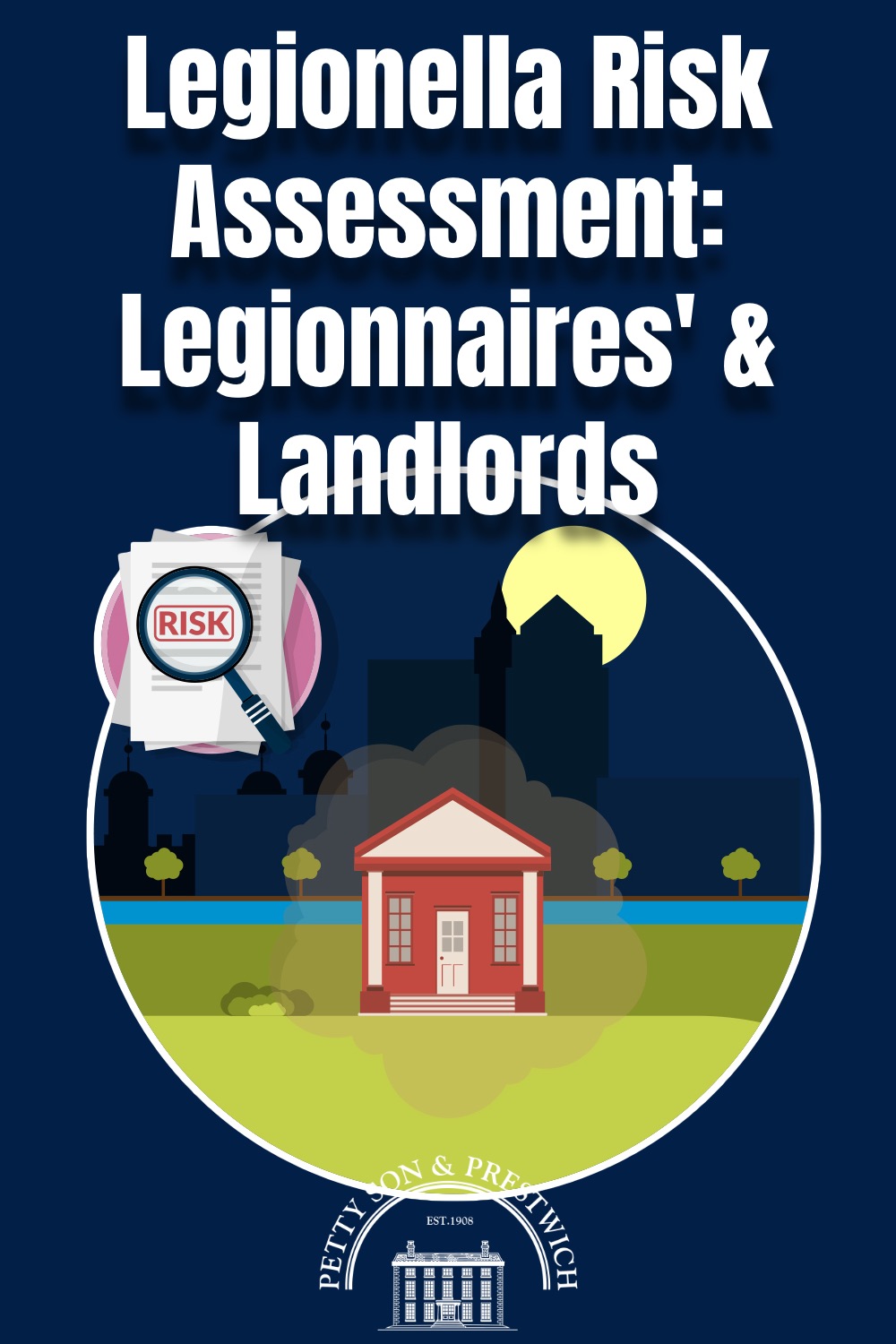Carrying out a Legionella risk assessment is part and parcel of being a landlord, and yet this important safety check gets far less attention than many of the other legal requirements and responsibilities landlords face.
Wording of the legislation behind testing for Legionella has also caught landlords out in the past, so today we’re going to do a deep dive into water safety and hopefully bring a little clarity to this sometimes confusing subject.
Before we get into what is required of landlords, let’s take a brief look at Legionella itself to see why it is such an important topic to be aware of.
What is Legionella?

In short, Legionella is a bacteria that can cause a severe form of pneumonia commonly known as Legionnaires' disease. Legionnaires’ disease is predominantly a water issue here in the UK, but it can also be contracted by inhaling the Legionella bacteria from soil, too.
As with any living organism, Legionella bacteria needs a specific environment in which to thrive. Modern day water systems provide prime locations for Legionella, especially when left unattended for a period of time, as they meet the bacteria’s temperature requirements and provide food by way of sludge, rust, scale, and/or biofilm.
It is these hot and cold water systems that the landlord needs to pay close attention to.
What are the symptoms of Legionnaires’ disease?
According to the Mayo Clinic, the following can be expected from those who have contracted Legionnaires’ disease:
Legionnaires' disease usually develops two to 10 days after exposure to legionella bacteria. It frequently begins with the following signs and symptoms:
- Headache
- Muscle aches
- Fever that may be 104 F (40 C) or higher
By the second or third day, you'll develop other signs and symptoms that can include:
- Cough, which might bring up mucus and sometimes blood
- Shortness of breath
- Chest pain
- Gastrointestinal symptoms, such as nausea, vomiting and diarrhea
- Confusion or other mental changes
Although Legionnaires' disease primarily affects the lungs, it occasionally can cause infections in wounds and in other parts of the body, including the heart.
A mild form of Legionnaires' disease — known as Pontiac fever — can produce fever, chills, headache and muscle aches. Pontiac fever doesn't infect your lungs, and symptoms usually clear within two to five days.
Who is most at risk?
As Legionnaires’ is a form of pneumonia, which is an infection that causes inflammation in the lungs, it will come as no surprise to hear that older adults and those who have a history of smoking are most at risk. Those with weakened immune systems also demonstrate greater susceptibility to contracting Legionnaires’ disease.
What are landlord’s legionella legal requirements?
Landlords have a legal responsibility to provide those who rent from them a home that is both safe and free from health hazards. This, naturally, includes assessing the risk of exposure to Legionella.
However, according to the Health and Safety Executive (HSE), this does not mean that a professional assessment report needs to be compiled, so landlords are free to carry out the Legionella risk assessment themselves (more on which later).
Are older properties at a greater risk of Legionella?
Kind of. Older properties may have older water systems installed that could potentially provide a better breeding ground for the bacteria to flourish in, but Legionella colonisation can also occur in relatively ‘new’ hot and cold water systems, too.
Therefore, old water systems that have been regularly maintained and kept in use throughout their lifespan shouldn’t pose any greater risk than a newer system. In fact, a newer water system that has been neglected would be a bigger threat, as it has been neither flushed or had the water contained within it kept moving.
It should also be kept in mind that water storage plays a major part in the formation of Legionella bacteria. Water drawn directly from the mains supply by a combi boiler, for example, will lower the risk of Legionella considerably. Therefore, switching out old water heaters for new can have a dramatic impact on a property’s risk potential.
Performing a Legionella risk assessment
Thankfully, carrying out a Legionella risk assessment isn’t too much of a bother and, as mentioned earlier, landlord’s are free to carry the assessment out themselves, providing they feel competent and knowledgeable enough about Legionella and the risks the bacteria poses.
If the landlord doesn’t feel as though they have the necessary ability to correctly assess the risk of Legionella, or simply doesn’t want to perform the assessment themselves, a professionally trained or accredited contractor can be called in to complete the task.
In most instances, a Legionella risk assessment is simple, straightforward, and without complication. Knowing the risks associated with hot and cold water systems and the factors that allow Legionella to thrive (see below) will allow landlords to make an honest assessment and put the necessary preventative measures in place to minimise the risk of colonisation.
What does a Legionella assessment entail?
Common steps taken when performing a Legionella risk assessment include:
- A close inspection of all water systems within the property
- Determining likely hazards and assessing the risk level of each
- Pinpointing who is at risk
- Making a written record of the findings
From here, identification and implementation of necessary control measures can be put in place to curb the risk of Legionella colonisation.
The above points are taken from a self-assessment of the water systems for Legionella. If you are employing a professional assessor, you can also expect them to carry out water tests from samples taken from the system. These are not legally required, but most professional Legionella inspections do involve this additional precautionary step.
How often are landlords required to assess Legionella risk?
Another wooly area of the Legionella legislation is how often landlords should carry out risk assessments for the bacteria. The word ‘periodically’ is used and the HSE suggests pairing it with other inspections that are mandatory to conduct, especially in property where gaining access is difficult.
The HSE disclose in their documentation that there is no legal requirement to conduct assessments either annually or on a biennial basis, but it’s a good idea to be as proactive as possible. Once every couple of years is a good rule of thumb, but don’t forget to perform an assessment whenever work has been carried out on the water system or when a tenancy comes to a close and before the new tenants move in.
Legionella contamination risk factors
As we touched upon above, there are certain factors required by the bacteria if it is to thrive. Unfortunately, domestic hot and cold water systems provide the starting blocks the bacteria needs to take hold, but the likelihood of serious contamination and colonisation is greatly exacerbated by the following:
- Water temperatures of between 20°C and 45°C
- The presence of ‘food’, such as sludge, rust, scale, biofilm
- Areas where water is aerated, misted, sprayed, or otherwise dispersed into the air
- Water being allowed to ‘sit’ for prolonged periods of time
- Tanks not being flushed or cleaned regularly enough
- Recirculation of stagnant water through the system
Legionella risk prevention: Steps you should take
Regardless of your findings post Legionella risk assessment, controlling any potential exposure should be priority number one. Thankfully, this isn’t too difficult to achieve, so there’s no excuses not to follow the steps below and lessen the Legionella risk in your properties:
- Service your boiler annually and perform routine pipework checks
- Prevent debris from building up within the system
- Frequently check seals on water tanks
- Remove any redundant pipework (dead legs)
- Flush the system regularly to ensure no water is left sitting. Stagnant water must be removed from the system, so void periods are times when landlords should be especially vigilant
- Keep water temperatures outside of the breeding range. Water kept at 60°C will not only prevent growth, it will also kill any Legionella bacteria present in the system
If you are thinking of installing a new water system, or if your old boiler has packed up, consider switching to instant water heaters and do away with your water tanks altogether. This simple move will dramatically lessen the chances of Legionella colonising your rental.
That’s it for Legionella risk assessments, but if you’re a landlord who is looking for regular information on all things lettings, sign up to our weekly newsletter. We post a new blog each week and the newsletter also contains a selection of the latest properties to hit our books. You won’t want to miss it!
